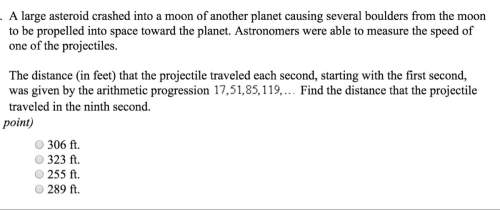
Mathematics, 16.01.2020 04:31 kailahgranger
hugo is writing a coordinate proof to show that the midpoints of a quadrilateral are the vertices of a parallelogram. he starts by assigning coordinates to the vertices of quadrilateral rstv and labeling the midpoints of the sides of the quadrilateral as a, b, c, and d. quadrilateral r s t v in a coordinate plane with vertex r at 0 comma 0, vertex s in the first quadrant at 2 a comma 2b, vertex t also in the first quadrant at 2 c comma 2 d, and vertex v on the positive side of the x-axis at 2 c comma 0. point a is between points r and s, point b is between points s and t, point c is between points t and v, and point d is between points r and v. enter the answers, in simplified form, in the boxes to complete the proof. the coordinates of point a are ( , ). the coordinates of point b are ( , ). the coordinates of point c are (2c, d) . the coordinates of point d are (c, 0) . the slope of both ab and dc is . the slope of both ad and bc is −bc−a . because both pairs of opposite sides are parallel, quadrilateral abcd is a parallelogram.

Answers: 1


Another question on Mathematics

Mathematics, 21.06.2019 17:00
In tossing one coin 10 times, what are your chances for tossing a head? a tail? 2. in tossing one coin 100 times, what are your chances for tossing a head? a tail? 3. in tossing one coin 200 times, what are your chances for tossing a head? a tail? deviation = ((absolute value of the difference between expected heads and observed heads) + (absolute value of the difference between expected tails and observed tails)) divided by total number of tosses. this value should always be positive. 4. what is the deviation for 10 tosses? 5. what is the deviation for the 100 tosses? 6. what is the deviation for 200 tosses? 7. how does increasing the total number of coin tosses from 10 to 100 affect the deviation? 8. how does increasing the total number of tosses from 100 to 200 affect the deviation? 9. what two important probability principles were established in this exercise? 10. the percent of occurrence is the obtained results divided by the total tosses and multiplied by 100%. toss the coins 100 times and record your results. calculate the percent occurrence for each combination. percent head-head occurrence: percent tail-tail occurrence: percent head-tail occurrence:
Answers: 3

Mathematics, 22.06.2019 00:30
Match the one-to-one functions with the graphs of their inverse functions.
Answers: 3

Mathematics, 22.06.2019 01:00
Divide reduce the answer to lowest term 3/7 divided 1 1/6
Answers: 3

Mathematics, 22.06.2019 02:30
Astudent found the solution below for the given inequality. |x-9|< -4 x-9> 4 and x-9< -4 x> 13 and x< 5 which of the following explains whether the student is correct? -the student is completely correct because the student correctly wrote and solved the compound inequality. -the student is partially correct because only one part of the compound inequality is written correctly. -the student is partially correct because the student should have written the statements using “or” instead of “and.” -the student is completely incorrect because there is no solution to this inequality.
Answers: 2
You know the right answer?
hugo is writing a coordinate proof to show that the midpoints of a quadrilateral are the vertices of...
Questions

Biology, 26.07.2019 07:20

Spanish, 26.07.2019 07:20

English, 26.07.2019 07:20

Biology, 26.07.2019 07:20




English, 26.07.2019 07:20


History, 26.07.2019 07:20



Mathematics, 26.07.2019 07:20


History, 26.07.2019 07:20

Health, 26.07.2019 07:20

SAT, 26.07.2019 07:20


Business, 26.07.2019 07:20

Computers and Technology, 26.07.2019 07:20




